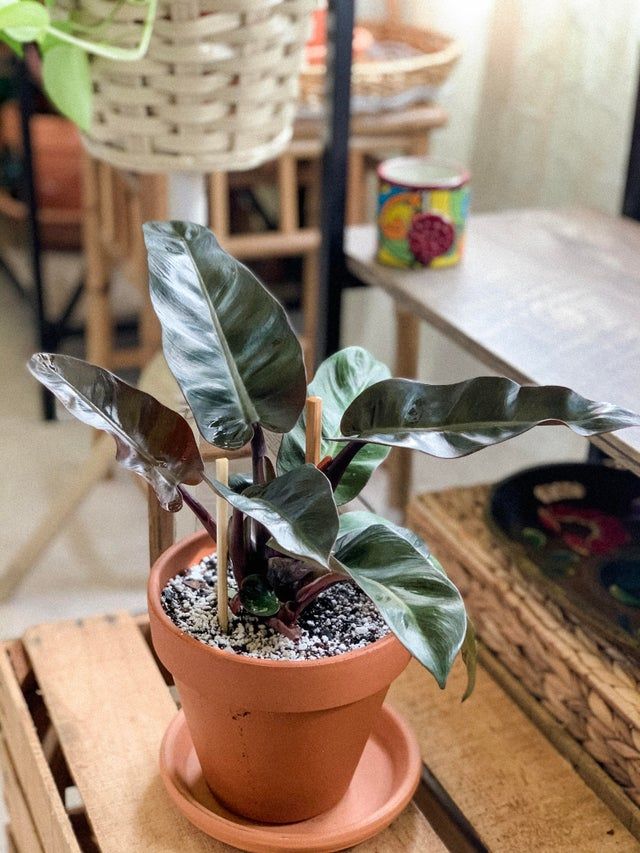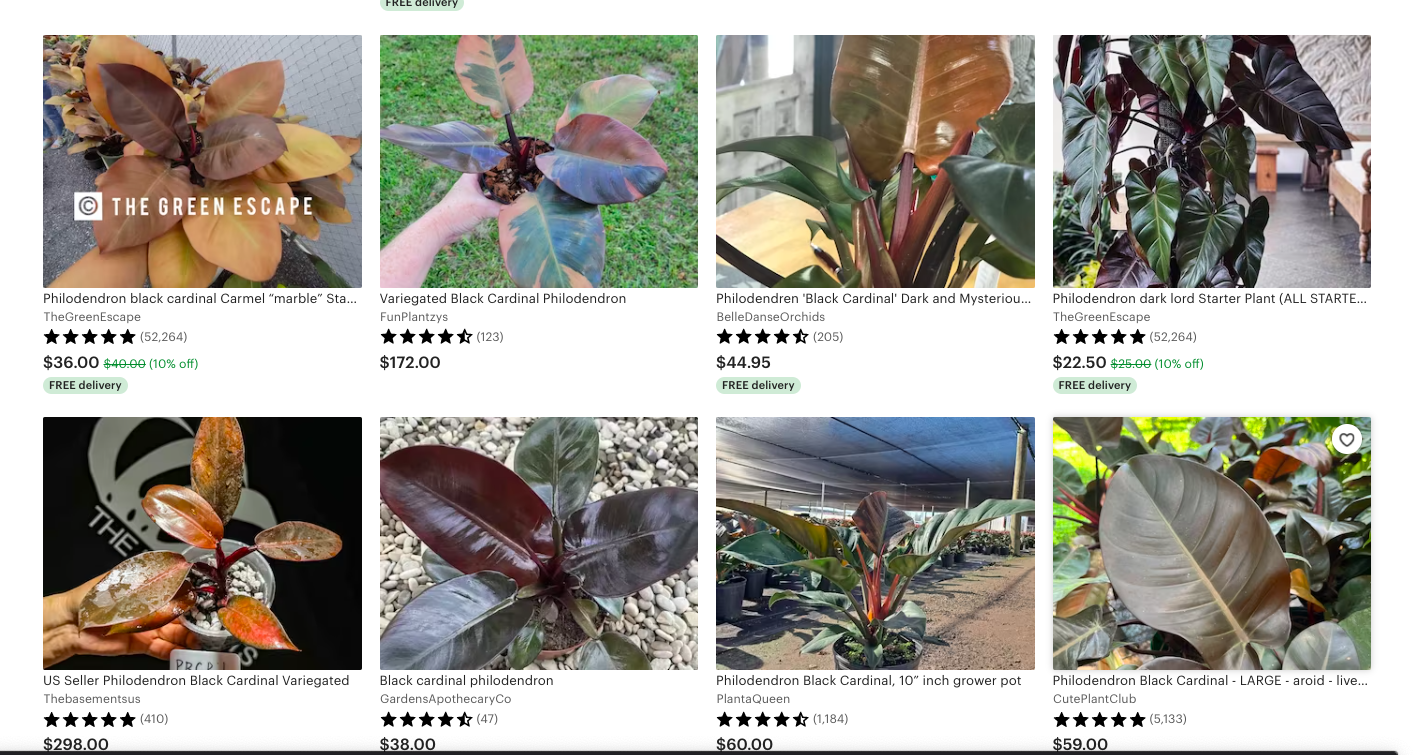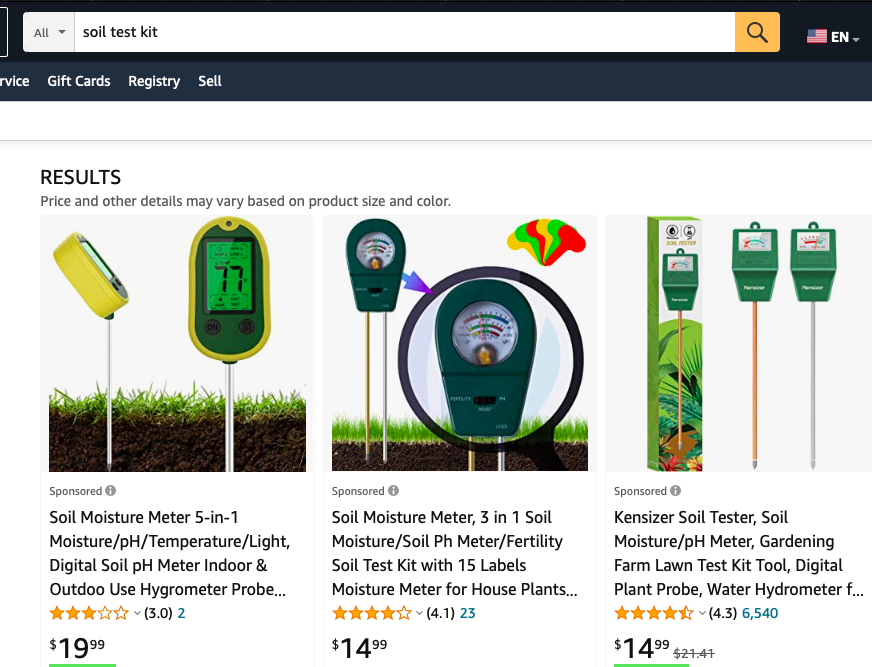Everything you need to know about the Black Cardinal Philodendron
Despite the name, the black cardinal is not entirely black. The foliage has a darkish-green color. They start out in bronze or burgundy color, then turn darker over time. Each leaf is oval in shape and measures about 1 foot in length and 8 inches across.

Background Information
The Philodendron Black Cardinal is a hybrid plant that was developed through interspecific hybridization within the genus Philodendron. It was created by crossing two different species of Philodendron, the Philodendron hastatum and the Philodendron hederaceum, and was released from R. H. McColley's breeding program at Bamboo Nursery in Apopka, Florida.
The Black Cardinal is known for its mahogany, almost black stems and petioles, brick red leaves, and its ability to tolerate low light conditions, making it a popular and widely used for interior decoration. It is also relatively easy to care for, some say it was cultivated specifically to be disease-resistant which makes it more attractive to beginner plant parents.
In addition to its decorative value, the Philodendron Black Cardinal is also known for its ability to filter the air, making it a useful plant to have in your home.
General care tips
- Light: Like other Philodendrons, the black cardinal can be quite flexible when it comes to its light requirements. It can tolerate low light levels. The plant may not grow quite well in the absence of light but will still survive. For best results, place the plant in a good spot where it can get several hours of sunlight.
- Watering: To determine when to water your Black Cardinal, you can simply stick your finger into the soil near the base of the plant. If the soil feels dry at a depth of about an inch, it is time to water the plant. If the soil is still moist at that depth, you can wait a few more days before watering again.
- Temperature and Humidity: The Philodendron Black Cardinal prefers a warm, humid environment and does well in temperatures between 70-85°F. It is generally recommended to keep the plant away from drafts or extreme temperature fluctuations, as these can cause stress and may lead to problems.
The Black cardinal also prefers high humidity levels, so you can either purchase a humidifier or go the DIY route and place the plant in the shower after a hot bath/shower. - Fertilizer requirements: The Philodendron Black Cardinal does not require a lot of fertilizer to thrive. However, like all plants, it can benefit from a little bit of extra nourishment from time to time to support its healthy growth.
If you want to fertilize your Black Cardinal, you can use a balanced liquid fertilizer, such as one with an N-P-K ratio of 20-20-20. Be sure to dilute the fertilizer according to the label instructions, as overfertilization can cause problems for the plant.
How do you identify a Black Philodendron Cardinal?

Despite the name, the black cardinal is not entirely black. The foliage has a darkish-green color. They start out in bronze or burgundy color, then turn darker over time. Each leaf is oval in shape and measures about 1 foot in length and 8 inches across.
To identify a Philodendron Black Cardinal, look for the following characteristics:
- Dark, almost black-colored leaves
- Compact, upright growth habit
- Tolerance for low light conditions
- Large, glossy leaves
- Heart-shaped leaves
If you are still unsure, check out r/houseplants on reddit, other plant parents can help identify the plant for you.
Is the Philodendron Black Cardinal rare?
It's difficult to say whether the Philodendron Black Cardinal is rare or not, as it depends on where you are located and how widely available it is in your area.
The Black Cardinal is a hybrid plant that was created by crossing two different species of Philodendron, and it is not a naturally occurring plant in the wild, so if that means rare then yeah sure.. it is rare.
However it is still a popular houseplant and is widely available at nurseries and garden centers, but it may be more difficult to find in some areas compared to others.
Below are some screenshots of a search across Etsy for the Black Cardinal plant, doesn't seem that rare to me based on the results.


Avoid using Alkaline soil with your Philodendron Black Cardinal
It is generally best to avoid using alkaline soil for the Philodendron Black Cardinal, as this type of soil can be harmful to the plant. The Philodendron Black Cardinal grows best in a soil mix that is slightly acidic, with a pH range of 6.0 to 6.5. Alkaline soil has a higher pH level and can cause problems for the Black Cardinal, as the plant may have difficulty absorbing nutrients from the soil if the pH is too high.
To help ensure that your Black Cardinal is growing in the best possible soil mix, you can use a soil test kit to determine the pH of your soil. This will help you identify any areas where the soil may be too alkaline or too acidic, and make any necessary adjustments to the soil mix to bring it into the optimal range for the plant.

By providing the plant with the proper soil mix and ensuring that the pH is within the optimal range, you can help your Black Cardinal grow and thrive.
Is the Philodendron Black Cardinal prone to Pests?

The Philodendron Black Cardinal is generally not prone to pest infestations. However, like all plants, it can occasionally be subject to pest problems. Some pests that may be attracted to Philodendron plants include aphids, mealybugs, and spider mites.
Is the Philodendron Black Cardinal a slow growing plant?
It is not true to say that the Philodendron Black Cardinal is a slow-growing plant. In fact, it is generally considered to be a fast-growing plant that can quickly outgrow its pot if not provided with enough space. It is generally a good idea to repot the plant every couple of years or when it becomes pot-bound to give it fresh soil and a larger pot to grow in.
Can the Black Cardinal Philodendron plant bloom Flowers?

Yes, the Philodendron Black Cardinal is capable of flowering, although it is relatively rare for the plant to do so when grown indoors. The flowers of the Black Cardinal are small and not particularly showy, and the plant is generally grown for its attractive foliage rather than its flowers.
Does Philodendron Black Cardinal need a moss pole?
A moss pole can be a useful tool for supporting the growth of a Philodendron Black Cardinal, as it can help the plant to climb and provide it with a structure to hold onto as it grows. However, it is not strictly necessary for the plant's survival, and the Black Cardinal can also be grown successfully without a moss pole.
Is the Philodendron Black Cardinal Toxic?
Yes, the Philodendron Black Cardinal is toxic to cats and dogs. If ingested, the plant can cause vomiting, diarrhea, and difficulty breathing in these animals. It is generally best to keep the plant out of reach of pets to prevent accidental ingestion.
It is important to note that all plants in the Philodendron genus are toxic to some degree, and many of them contain a substance called calcium oxalate, which can cause irritation and swelling of the mouth and throat if ingested. In addition to the Black Cardinal, other toxic Philodendron species include the Heartleaf Philodendron, the Elephant Ear Philodendron, and the Horsehead Philodendron.
If you have pets in your home and you are considering adding a Philodendron Black Cardinal to your collection, it is important to be aware of the potential risks and take steps to keep your pets safe. This may include keeping the plant out of reach of pets, or choosing a non-toxic plant species instead. Overall, it is important to be aware of the potential risks associated with any toxic plants you may have in your home, and to take steps to keep your pets safe.
How do you repot a Black Cardinal Plant?
Repotting a Philodendron Black Cardinal is a fairly straightforward process that can be done to help the plant grow and thrive. Here are the steps to follow when repotting a Black Cardinal:
- Choose a new pot that is slightly larger than the current one and has drainage holes.
- Remove the plant from its current pot by gently grasping the base of the stem and pulling it out of the pot.
- Loosen the roots gently with your fingers to encourage healthy new growth.
- Place the plant in the new pot and fill in around the roots with fresh, well-draining soil mix.
- Water the plant well and allow it to drain fully.
- Place the plant in a location with indirect light and normal room temperature.
It is generally a good idea to repot a Philodendron Black Cardinal every couple of years or when the plant becomes pot-bound, which means that the roots have filled up the pot and there is no more room for them to grow. Repotting the plant will give it fresh soil and a larger pot to grow in, which can help it to thrive.
Conclusion
In conclusion, the Philodendron Black Cardinal is a stunning and versatile houseplant that can add a touch of drama and sophistication to any indoor space. Its glossy, almost black-colored leaves and upright growth habit make it a decorative addition to any room.
Although the plant is relatively easy to care for, it is important to provide it with the right conditions to ensure that it thrives. This includes using a well-draining soil mix, watering the plant regularly, providing it with bright, indirect light, and maintaining a warm, humid environment.